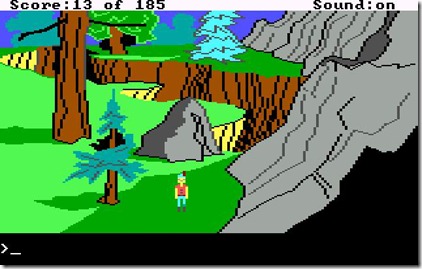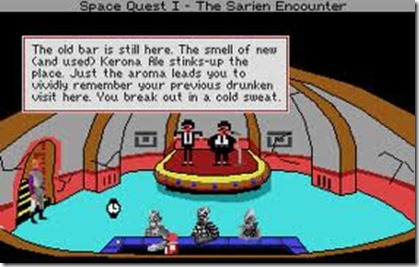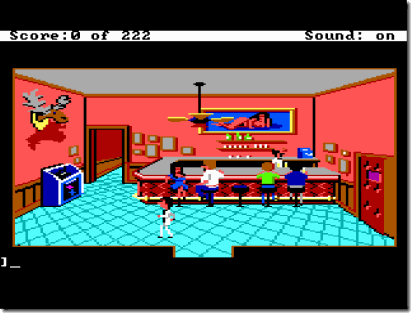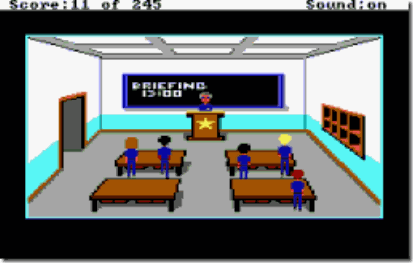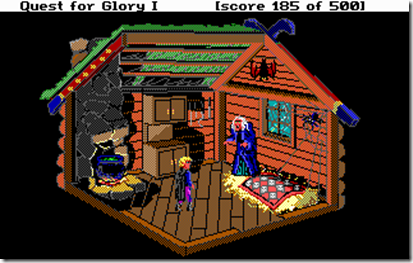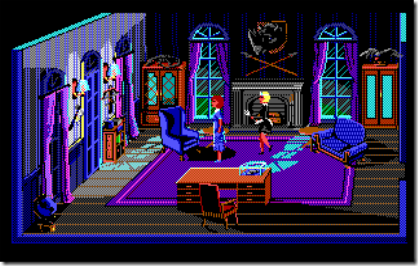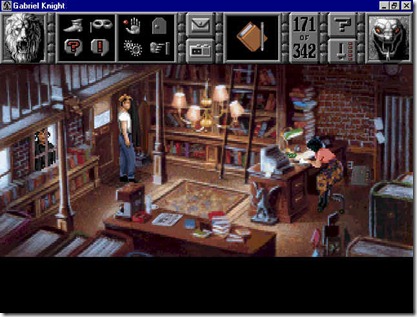Tadam! The return of what was supposed to be a regular feature on this blog…
Today, I’d like to delve into the Sierra games. This is not supposed to be a complete list of all Sierra games (not by a long shot!), but more of an overview of games that really influenced me.
Although Sierra has many more games, it’s mainly known for its graphical adventures. Founded in 1979 by Ken and Roberta Williams and was (arguably) the first game development company to mix the common and popular (at the time) text adventures with some “high-definition” graphics.
This post is about the graphical adventures, there will be other Sierra games I discuss in other posts…
Most of these games feature controlling a character around the screen and interacting with the world by text commands.
I played most of them on the Commodore Amiga (so I had better graphics), but some of the later ones I played on the PC.
I’m going to talk about the games in terms of series, and in chronological order (not the order I played them).
The “King’s Quest” series wasn’t the first Sierra game, but it was the first for the PC and is probably the most iconic of the lot, spanning 15 years of releases (1983 to 1998), with 8 games in the series (plus some spinoffs, a remake and the announced new episodic King’s Quest from Telltale Games).
The game followed the plights and tribulations of the royal family of Daventry and it was designed by Roberta Williams. The graphics now look extremely crude, but for the time they were amazing, specially compared to other adventure games.
This series has lots of mutation throughout its life, beyond improved graphics: first game with a female lead (King’s Quest IV: The Perils of Rosella), removing the text interface (King’s Quest V: Absence Makes the Heart Go Yonder), Disney like animation and singing (King’s Quest VII: The Princeless Bride), and full 3d (King’s Quest VIII: Mask of Eternity).
The games were good because of the use of lots of references from classic fantasy, like Little Red Riding Hood or Count Dracula. It made the world seem familiar, although its own identity was strong enough not to be overwhelmed and become stale because of that familiarity.
Created by Mark Crowe and Scott Murphy (alias known as “Two Guys from Andromeda”), the Space Quest series was my favorite one. Using the same game style as King’s Quest (in fact, most Sierra graphical adventures used the same engine, evolved from game to game), it featured the adventures of Roger Wilco, a perpetual loser. The game would parody lots of existing space franchises, like Star Wars or Star Trek.
The humor was the trademark of these adventures, and laugh I did… everytime I identified something from a known scify movie, I’d be terribly happy! Ah, simpler times…
The series started losing its charm when the Two Guys from Andromeda split up as a team (circa Space Quest V), but the four games they worked on together were pure magic (they were even characters in Space Quest III, which we rescue from the Pirates of Pestulon. We then proceed to bring them to Earth where Ken Williams hire them to make Space Quest!).
The raunchier of the group, this graphical adventure series created by Al Lowe is one the most well known of the Sierra catalogue.
It featured a character called Larry Laffer, a 40-year old man on his quest to get laid. The game seemed much more “sexual” in nature than it was in fact (and for today’s standards it is pretty mild).
Again, humor is the keyword here, the game making numerous references to 80’s iconic sex-symbols and seduction settings.
This was an extremely hard game for me to play as a kid (it wasn’t hard getting my hands on it, even though I wasn’t old enough to play it), because it required some knowledge about sex that I didn’t yet possess (although that didn’t stop me from finishing it and thinking: “what the hell?!”).
I’ve only followed this series until “Love for Sail”, but to be honest I felt it was terrible and gave up on the series.
Police Quest is by far the most “serious” of all Sierra games… It was created by former policeman Jim Walls, which directed the series until Police Quest III. He left before the game was finished by reasons unknown, and the remaining games of the series (including the spinoff series “SWAT”) were taken over by former police Chief Daryl F. Gates.
I only followed this series until the 3rd one. The visuals on the 4th (photographed instead of drawn) put me off (at the time, even photographs looked terrible on a computer, so I was stuck in the uncanny valley).
The games had emphasis on following good police procedure (for example, you’d have to check the tires of the car before leaving the precinct or you’d have a flat tire and had to reload the game). The game featured driving around town in a top down map, police chases and police work collecting clues and such… For this, a map was provided to know the names of the streets and such, but I didn’t had access to original games at the time, so I had to learn them and create my own map: more fun! ![]()
These games had a very good atmosphere, drawing you really into the police life and making you feel nervous about going into situations.
Initially called “Hero’s Quest”, this was my second favorite series from Sierra… Created by Corey and Lori Ann Cole, it featured RPG elements and allowed a player to import a save game from a previous game (actually importing his character, with the skills and wealth you previously had).
Each of the five games in the series borrowed heavily from a specific mythos, from Slavic to African tradition, to everything in between.
The role playing element influenced the game very much, and separated it from the other fantasy series in the Sierra catalogue (“King’s Quest”). You could choose to be a warrior, magic-user or thief, and some puzzles had different solutions depending on this (and how high your skill levels were). This sometimes became a bit frustrating, since some puzzles would require you to do tedious tasks in order to level up a particular skill, but the feeling of epicness was huge!
The stories tied into a big arc, to be resolved on “Quest for Glory V: Dragon Fire”. Unfortunately, due to financial issues, the game was a bit rushed and it feels like an anti-climax…
The two Laura Bow games, “The Colonel’s Bequest” and “The Dagger of Amon Ra” were more “under-the-radar” titles than the usual Sierra fare.
This was probably due to the key point in “The Colonel’s Bequest”: events took place in semi-realtime. This meant that revisiting locations was important, because the environment would change depending on the time (or other actions somewhere in the game).
The idea of “The Colonel’s Bequest” was to create a real “murder mystery”-type of game (like the first games Roberta Williams designed for the Apple II, like Mystery House), it was right on the nose on that. Finding the murderer was really rewarding, although it was extremely hard for the time.
The sequel, “The Dagger of Amon Ra” was much more straightforward and back to the origins, taking less risks in terms of game design. That can be explained by the fact that Roberta Williams wasn’t involved anymore. The story was much less ambitious as well, using more stereotypical settings and characters than usual in a Sierra game.
Created by Jane Jensen, this series was a weird one for me… Although I loved the first one, I loathed the following, mostly because of the art approach (replacing hand drawn graphics by full motion video, with less than stellar interpretations).
The first game takes place in New Orleans and involves a mystery with voodoo contours. The games atmosphere was amazing (specially considering this is a 1993 release), and the writing is really good (a constant throughout the series, even with me not appreciating the sequels).
The Sierra graphical adventures might not have been the best games ever, but they are certainly some of the most influential… in a time where most game stories were “aliens are invading, shoot them!” or extremely boring text-based adventures, they opened a new door combining imagination and game, mixing them seamlessly to create an experience that I seldom felt so strongly about since. From the sheer scope of the games (from space operas to fantasy RPGs), to the risks taken in producing them (innovating just enough to keep ahead of the competition, but not so much as to lose that special something), Sierra has been successful in not only building great games, but in building a legacy…
Every time I create a story for a game, I can’t help but feel that I’m paying homage to the past where I spent so much of my time… For example, I can’t help but compare “Blitz and Massive” to “Space Quest”…
Sierra will always have a piece of my art due to these games and I was extremely sorry when they faded and disappeared (even if I didn’t think their last graphical adventures measured to the old ones)…
